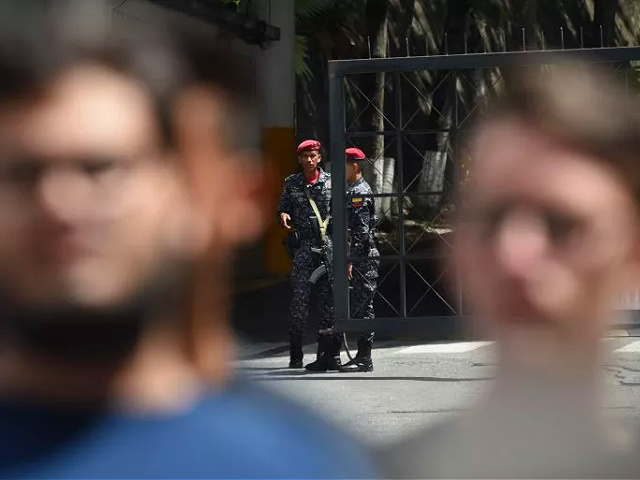CARACAS, Venezuela — Officials in Venezuela’s socialist regime, a notorious human rights abuser, inspected the facilities of a brand new detention center on Wednesday named after the late South African President Nelson Mandela.
The “Nelson Mandela Detention Center,” located in Venezuela’s capital Caracas, will, according to Justice and Peace Minister Remigio Ceballos, “strengthen” the nation’s justice system and begin operations soon. The regime has not offered a specific date for its launch.
“This center is in the process of being acclimated and it will temporarily house detained persons to guarantee that the organs of citizen security execute all of their initial tasks following apprehension [of the prisoner],” claimed the minister.
Nelson Mandela was one of the world’s best-known political prisoners. The South African icon was imprisoned for 27 years for opposing the nation’s apartheid system in a small cell without a bed or plumbing. Following his liberation, he served as the country’s first post-apartheid leader.
Venezuelan human rights Marino Alvarado described the new detention center this week as an “insult to the figure of Nelson Mandela in a country where there are constant violations of prisoners, including deaths from torture.”
The inspection of the detention center took place as International Criminal Court (ICC) prosecutor Karim Khan announced on Wednesday that he will visit Venezuela as part of the ICC’s ongoing investigation into allegations of torture, extrajudicial killings, and other crimes against humanity committed by the Maduro regime. The Maduro regime has for decades imprisoned political dissidents.
Khan asserted there is a “reasonable basis” to believe that the socialist regime has committed crimes against humanity that are “serious and require investigation and prosecution.” The International Criminal Court announced in April that it had so far collected the testimonies of roughly 8,900 victims.
The United Nations confirmed in an independent fact-finding mission that the Maduro regime ordered its intelligence and military agencies to commit acts of torture, sexual violence, and other inhumane and degrading treatment on political opponents and dissenters. The Maduro regime immediately rejected the U.N. report, accusing it of being a “pseudo report” that masked “obscure interests” against Venezuela.
The U.N. allowed Venezuela to serve on its Human Rights Council through October when its term on the body ended.
Ceballos told the state-owned newspaper Ciudad CCS on Wednesday that the Maduro regime always had the “highest interest” in “dignify[ing]” the prisoner and that the Nelson Mandela Detention Center is built with “dignified spaces” that guarantee a “humanized process” for the detainees.
Some of the Maduro regime’s torture victims have narrated their harrowing experiences, with several of them having been imprisoned and tortured in the Helicoide (“the Helix”), an unfinished facility that began construction in the 1950s during the dictatorship of Marcos Pérez Jiménez that, had it been finished, would have become the world’s first drive-thru mall.
The unfinished infrastructure has been occupied since the 1980s by Venezuelan security agencies — and, since the rise to power of Hugo Chávez’s socialist revolution in 1999, has become an infamous detention and torture center for political prisoners.
Víctor Navarro, a Venezuelan citizen who was imprisoned in the Helicoide, narrated his experience at the Helicoide at an event held on Tuesday.
“The Helicoide is a torture center, in Venezuela there are illegal torture centers,” Navarro said. “They are not normal prisons. There, they answer directly to Maduro and torture civilians and soldiers. These are things that continue to happen.”
“People are electrocuted, drowned, suffocated, killed in the Helicoide,” he continued. “They are not allowed to see the sun or have visits from relatives.”
American citizen Joshua Holt spent two years imprisoned in the Helicoide without a trial after Venezuelan police officials accused him of stockpiling an AK-47 assault rifle and grenades at his fiancée’s family home, which he vehemently denied and claimed no evidence existed for.
Holt was subject to inhumane treatment throughout his two years in the Helicoide. He was reportedly forced to perform calisthenics naked, in violation of his religious beliefs, and the prison’s unhygienic status caused him to suffer numerous health complications and infections. Holt was released in 2018 after the administration of former American President Donald Trump successfully negotiated his liberation.
Another torture center — no less infamous than the Helicoide — exists in Caracas and is commonly referred to as La Tumba (“The Tomb”).
La Tumba, an underground detention facility, is located on the basement floors of a building initially constructed to serve as offices for Caracas’ subway network, now serving as the headquarters of the Maduro regime’s Bolivarian Intelligence Service (SEBIN). Detainees are thrown in extremely small white and gray cells with concrete beds, are placed under 24/7 surveillance, and are subjected to a series of psychological torture and sensory deprivation techniques known as “white torture.”
Venezuelan student leader Lorent Saleh, who spent four years imprisoned, described the types of torture he experienced in a series of interviews in 2018.
“I saw men on their knees so they could be beaten. And the worst – the most terrible and striking – I saw men not do anything before the suffering of other men,” Saleh explained. “I have seen prisoners hanging for three days on a rail. Crucified. And other prisoners pass him by, as if nothing.”
In March, the U.S. Department of State released a report on human rights violations committed by the Maduro regime, listing murders, disappearances, and torture committed by state security forces.
Christian K. Caruzo is a Venezuelan writer and documents life under socialism. You can follow him on Twitter here.
